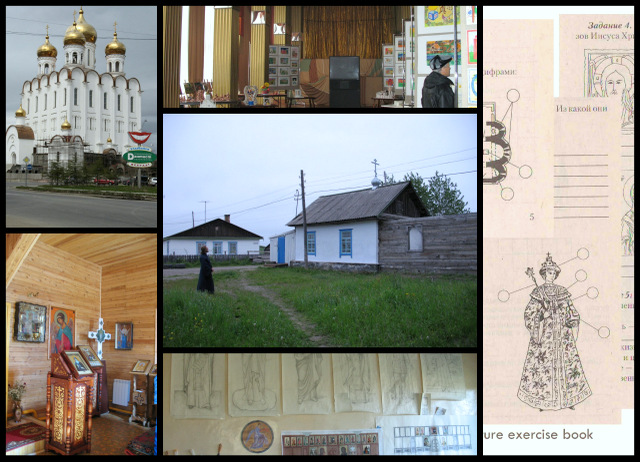Projects
Covenant as narratives and praxis of social relations in Dessie, Ethiopia (2009-2013)

For my doctoral research, I studied the dynamics of parish relations in several churches in an urban centre in northern Ethiopia and I conducted sixteen months of fieldwork, from mid-2010 to early 2012. My aim was to learn how Orthodox Christians incorporated traditions of worship in their day-to-day activities and relations, focusing on 'the church' as an institutional unit and a source of inspiration for how Orthodox Christian religiosity is devised and elaborated by laypeople. Pivotal investigations of this ethnographic work were to evaluate subscribed actions such as preparation to receive the sacrament, attending liturgical services and partaking in the ebb and flow of life patterns and the structural enactment of Ethiopian Orthodox theology as it is negotiated within cultural traditions, such as pilgrimage-making, formations of charity groups, and devotional activities in the home. Key methodologies included consulting local records such as historical archives and tourism media, reports on socio-economic development, population demographic statistics and regional environmental data. These analytical tools I applied to examine the role of grassroots-level institutions within the civic culture. This vantage point permitted investigating several burning issues occurring in Ethiopia, such as governmental land reform and its effects of rights to property, the hyper-commercialization of industries, and the political reconfigurations of social diversity. These factors served as key indicators for the management of socio-economic development agenda in locales that are emerging in global exchanges.
My thesis, Expressions of Sacred Promise: Ritual and Devotion in Ethiopian Orthodox Praxis, attended to the regional provenance of religious and ethnic pluralism by exploring the socio-historical conditions of cultural contact within Ethiopian Orthodox Christianity via the intermingling of Abrahamic faiths in longue durée. I tracked the genesis and development of what I term as a covenant genre -- a cultural figure of thought that promotes social cohesion and cooperation. I argued that "covenant", as a series of locally elaborated tropes, symbols, and metaphors, developed dialectically in response to multi-confessional demographics of the region. I positioned this concept as an operational guide behind contemporary practices of fellowship, mutual aid, and shared culture I studied in urban Ethiopian contexts. I offered an innovative approach to religious studies by re-imagining a core theological concept, often considered a mainstay of political theories on national exceptionalism, that is, the "chosen people" thesis. My analysis was dynamic because it adopted a synchronic approach to tradition as a domain of innovation. I argue that conventional domains such as liturgical space/time (e.g. feast days) and saint tribute associations implicate individuals in personalized manner, generated around reciprocal movement of giving and receiving, and thus permits conceiving of transformative change as internal to tradition-based spheres such as the church. For Ethiopian Orthodox Christians, covenant has been both a series of archetypal promise-making and a circulating narrative, and thus represents a dynamic instance where understanding significations can be unlocked by the careful appraisal of cultural reference points and tropes. Furthermore, this scholarship made visible critical evidence of locally embedded ideologies of pluralism that challenged working anthropological assumptions on social difference and contemporary urbanization.
Public spaces and infrastructures of religious organization in post-Soviet Magadan (2006-2008)
This research project studied patterns of congregation building in a metropolis in the Russian Far East, as part of a multi-country research team part entitled "New Religious Movements in the Russian North: Competing Uses of Religiosity", funded by National Science Foundation and European Science Foundation. Magadan, a city founded after the establishment of the Soviet Union, represented a 'clean slate' for several faith groups seeking to install permanent presence in the aftermath of a historical era when religious organization primarily operated underground. I charted the growth of this diocese of Russian Orthodox Church (1991 to 2007), in order to investigate how Orthodoxy represented one among many identities competing for relevance by the public in the early days of Russia's political restructuring. My study posed the question of foundational growth of everyday religion by both evaluating the Church as a public institution, by looking at its infrastructural changes, and evaluating the church as a community by the engagement of its adherents. This contrast aimed to draw out the multiple understandings and manifestations of the Russian Orthodox Church and to position these perspectives to show how the place of religion in the mainstream political culture was continuously negotiated.

This project utilized several methodologies, such as reviewing art exhibits produced by the local House of Culture and conducting content analyses of periodicals and online content on the key trends on religious movements and Russian legislation. This data was employed to examine the conditions of a populated field of ideologies disseminated via traditional bodies such as the Orthodox Church and the emerging influences such as humanitarian aid. In brief, this project featured the tenuous situation of the institutional presence of religion as experienced in Madagan, a place that became more visibly Orthodox Christian in a short span of time but also continued to refer to local customs of "hidden practice" that is, worship outside the presence of an 'official' church. Individuals and small groups carried on inherited traditions of religiosity developed during the Soviet era when fellowship activities of faith communities were prohibited. Such historical circumstances prompted certain advocates of the necessity for more comprehensive education on the roots of Russian culture. I consulted with local educators, officials of the diocese, parents and students who endorsed initiatives to incorporate religious themes in the public schools and local media. The results of this research contextualized the demographic trends that reported a peaking interest for claiming religious affiliation during Russia's social reconstruction period, and offered insights on the impact of worship domains outside of public religious institutions to progress autonomous and oftentimes counter-cultural identities and values.
See journal article on this project, "Hidden Practice in Magadan: Parishioner Anxieties and Diocesan Perspectives on Russian Orthodoxy"